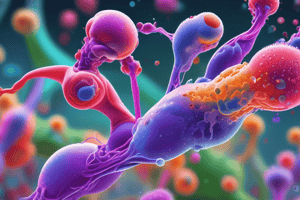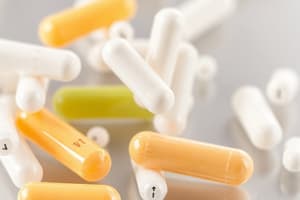Podcast
Questions and Answers
What is meant by selective toxicity?
What is meant by selective toxicity?
Chemotherapeutic agents should act against the pathogen and not the host.
Why are chemotherapeutic agents that work on the peptidoglycan cell wall of bacteria a good choice of drug?
Why are chemotherapeutic agents that work on the peptidoglycan cell wall of bacteria a good choice of drug?
Humans and other animal hosts lack peptidoglycan cell walls.
Why is polymyxin only used on the skin?
Why is polymyxin only used on the skin?
It can also damage living human cell membranes, but the drug is safely used on the skin, where the outer layers of cells are dead.
Quinolones and fluoroquinolones act against what bacterial target?
Quinolones and fluoroquinolones act against what bacterial target?
Why is it difficult to find good chemotherapeutic agents against viruses?
Why is it difficult to find good chemotherapeutic agents against viruses?
If penicillin G is chosen as the best treatment for a given infection, what microorganisms are most likely the cause?
If penicillin G is chosen as the best treatment for a given infection, what microorganisms are most likely the cause?
Why is methicillin-resistant Staphylococcus aureus (MRSA) methicillin resistant?
Why is methicillin-resistant Staphylococcus aureus (MRSA) methicillin resistant?
Why is it more difficult to treat viral infections than it is to treat bacterial infections?
Why is it more difficult to treat viral infections than it is to treat bacterial infections?
A new bacterial molecule is discovered that inactivates an antibiotic. Which category best describes the mechanism of antibiotic resistance conferred by this molecule?
A new bacterial molecule is discovered that inactivates an antibiotic. Which category best describes the mechanism of antibiotic resistance conferred by this molecule?
Which antibiotic is overcome by beta-lactamases?
Which antibiotic is overcome by beta-lactamases?
How might efflux pumps increase antibiotic resistance in bacteria?
How might efflux pumps increase antibiotic resistance in bacteria?
Bacteria that are resistant to sulfonamide have enzymes that have a greater affinity for what?
Bacteria that are resistant to sulfonamide have enzymes that have a greater affinity for what?
Why would an efflux pump for penicillin located on a bacterial cell membrane not be effective at providing resistance to the drug?
Why would an efflux pump for penicillin located on a bacterial cell membrane not be effective at providing resistance to the drug?
Membrane transport proteins are required for which mode(s) of antibiotic resistance?
Membrane transport proteins are required for which mode(s) of antibiotic resistance?
What is meant when a bacterium is said to become 'resistant' to an antibiotic?
What is meant when a bacterium is said to become 'resistant' to an antibiotic?
When a patient is treated with antibiotics, __________.
When a patient is treated with antibiotics, __________.
The process of acquiring antibiotic resistance by means of bacteriophage activity is called?
The process of acquiring antibiotic resistance by means of bacteriophage activity is called?
Which of the following mutations would not result in antibiotic resistance?
Which of the following mutations would not result in antibiotic resistance?
R-plasmids are most likely acquired via?
R-plasmids are most likely acquired via?
Consider a Kirby-Bauer disk-diffusion assay. If you put penicillin and streptomycin disks adjacent to one another, the zone of inhibition is greater than that obtained by either disk alone. This is an example of __________.
Consider a Kirby-Bauer disk-diffusion assay. If you put penicillin and streptomycin disks adjacent to one another, the zone of inhibition is greater than that obtained by either disk alone. This is an example of __________.
Which of the following would be selective against the tubercle bacillus?
Which of the following would be selective against the tubercle bacillus?
Drug resistance occurs?
Drug resistance occurs?
Which of the following statements about drug resistance is FALSE?
Which of the following statements about drug resistance is FALSE?
Which of the following organisms would MOST likely be sensitive to natural penicillin?
Which of the following organisms would MOST likely be sensitive to natural penicillin?
The antimicrobial drugs with the broadest spectrum of activity are?
The antimicrobial drugs with the broadest spectrum of activity are?
To date, most of our natural antibiotics have been found to be produced by members of what genus?
To date, most of our natural antibiotics have been found to be produced by members of what genus?
More than half of our antibiotics are?
More than half of our antibiotics are?
Which of the following antibiotics is recommended for use against gram-negative bacteria?
Which of the following antibiotics is recommended for use against gram-negative bacteria?
Which of the following antimicrobial agents has the fewest side effects?
Which of the following antimicrobial agents has the fewest side effects?
In what way are semisynthetic penicillins and natural penicillins alike?
In what way are semisynthetic penicillins and natural penicillins alike?
Penicillin was considered a 'miracle drug' for all of the following reasons EXCEPT?
Penicillin was considered a 'miracle drug' for all of the following reasons EXCEPT?
Which statement regarding tests for microbial susceptibility to chemotherapeutic agents is FALSE?
Which statement regarding tests for microbial susceptibility to chemotherapeutic agents is FALSE?
Flashcards
Selective Toxicity
Selective Toxicity
The ability of a chemotherapeutic agent to harm pathogens without harming the host.
Peptidoglycan Cell Wall
Peptidoglycan Cell Wall
A unique structural component of bacterial cell walls that is absent in human cells, making it a target for antibiotics.
Polymyxin
Polymyxin
An antibiotic that can damage human cell membranes but is safe for external use due to the dead outer skin layers.
Quinolones/Fluoroquinolones
Quinolones/Fluoroquinolones
Signup and view all the flashcards
Viral Infection Treatment
Viral Infection Treatment
Signup and view all the flashcards
Penicillin G
Penicillin G
Signup and view all the flashcards
MRSA Resistance
MRSA Resistance
Signup and view all the flashcards
Viral Reproduction
Viral Reproduction
Signup and view all the flashcards
Antibiotic Resistance
Antibiotic Resistance
Signup and view all the flashcards
Efflux Pumps
Efflux Pumps
Signup and view all the flashcards
Sulfonamide Resistance
Sulfonamide Resistance
Signup and view all the flashcards
Penicillin Resistance
Penicillin Resistance
Signup and view all the flashcards
Membrane Transport Proteins
Membrane Transport Proteins
Signup and view all the flashcards
Bacterial Resistance
Bacterial Resistance
Signup and view all the flashcards
Antibiotic Treatment Effect
Antibiotic Treatment Effect
Signup and view all the flashcards
Transduction
Transduction
Signup and view all the flashcards
Mutation and Resistance
Mutation and Resistance
Signup and view all the flashcards
R-Plasmid Acquisition
R-Plasmid Acquisition
Signup and view all the flashcards
Synergism in Antibiotic Interaction
Synergism in Antibiotic Interaction
Signup and view all the flashcards
Ethambutol
Ethambutol
Signup and view all the flashcards
Drug Resistance and Misuse
Drug Resistance and Misuse
Signup and view all the flashcards
Drug Resistance Misconception
Drug Resistance Misconception
Signup and view all the flashcards
Natural Penicillin
Natural Penicillin
Signup and view all the flashcards
Broad-Spectrum Antibiotics
Broad-Spectrum Antibiotics
Signup and view all the flashcards
Natural Antibiotic Production
Natural Antibiotic Production
Signup and view all the flashcards
Antibiotic Efficacy
Antibiotic Efficacy
Signup and view all the flashcards
Penicillin Forms
Penicillin Forms
Signup and view all the flashcards
Penicillin Significance
Penicillin Significance
Signup and view all the flashcards
Microbial Susceptibility Testing
Microbial Susceptibility Testing
Signup and view all the flashcards
Study Notes
Selective Toxicity and Chemotherapeutic Agents
- Selective toxicity refers to the ability of chemotherapeutic agents to target pathogens without harming the host.
- Ideal agents act specifically against pathogens, minimizing side effects on human cells.
Peptidoglycan Cell Wall Targeting
- Drugs that target bacterial peptidoglycan cell walls are effective since human cells lack this structure.
- Bacteria are particularly vulnerable to these antibiotics, making them a preferred choice.
Polymyxin Usage
- Polymyxin can damage human cell membranes but is safe for external use due to dead outer skin layers.
- Its instability in acidic environments limits oral use.
Mechanism of Action for Quinolones and Fluoroquinolones
- These antibiotics specifically target DNA gyrase, an essential enzyme in bacterial DNA replication.
Challenges in Viral Infection Treatment
- Finding effective antiviral agents is challenging due to viruses using host cellular machinery for replication.
- Selective targeting of viral processes without affecting the host remains complex.
Penicillin G Effectiveness
- Penicillin G is particularly effective against gram-positive bacteria, making it a common treatment choice for infections caused by these organisms.
MRSA Resistance Mechanism
- Methicillin-resistant Staphylococcus aureus (MRSA) has modified its target molecule to resist methicillin, rather than degrading or pumping it out.
Viral Reproduction Dependence
- Viruses rely on host cellular processes for their reproduction, complicating treatment strategies.
Antibiotic Resistance Mechanisms
- Resistance can involve bacterial enzymes that inactivate drugs or modified porins preventing entry.
- Efflux pumps, which expel antibiotics, contribute to resistance by allowing bacteria to survive despite exposure.
Specificity in Enzyme Resistance
- Bacteria resistant to sulfonamide possess enzymes with a higher affinity for PABA, competing effectively with the drug.
Penicillin Resistance Limitations
- Efflux pumps do not aid in penicillin resistance due to the drug's mode of action affecting the cell wall outside the cell membrane.
Role of Membrane Transport Proteins
- Antibiotic resistance through efflux pumps, beta-lactamases, and modified porins requires transport proteins for effective function.
Defining Bacterial Resistance
- Bacterial resistance indicates that the antibiotic no longer kills or inhibits the growth of the bacteria.
Effects of Antibiotic Treatment
- Antibiotics eliminate sensitive bacteria, leading to a selection of those that are resistant.
Gene Transfer in Antibiotic Resistance
- Transduction refers to the process where bacteriophages help transfer antibiotic resistance genes between bacteria.
Mutation Types and Resistance
- Silent mutations do not result in antibiotic resistance, while others, like missense and nonsense mutations, can.
R-Plasmid Acquisition
- Bacterial conjugation is the primary method by which R-plasmids, conferring resistance, are acquired among bacteria.
Synergism in Antibiotic Interaction
- When two antibiotics, such as penicillin and streptomycin, show greater effectiveness together than separately, it exemplifies synergism.
Specific Antibiotic Actions
- Ethambutol selectively targets the tuberculosis-causing bacillus by inhibiting mycolic acid synthesis.
- Drug resistance often arises when antibiotics are used indiscriminately.
Misconceptions About Drug Resistance
- Drug resistance is not exclusive to gram-negative bacteria; it can occur in various bacterial strains.
Susceptibility Indicators
- Natural penicillin is notably effective against Streptococcus pyogenes, making it a go-to treatment.
Broad-Spectrum Antibiotics
- Tetracyclines are recognized for having one of the widest spectra of antimicrobial activity.
Natural Antibiotic Production
- Most natural antibiotics are produced by bacteria, particularly from the genus Streptomyces.
Antibiotic Efficacy
- Polymyxin is specifically effective against gram-negative bacteria, while penicillin has fewer side effects.
Comparison of Penicillin Forms
- Both semisynthetic and natural penicillins share a foundation in β-lactam structure.
Significance of Penicillin
- Although considered a "miracle drug," penicillin was not the first antibiotic; its selective toxicity and impact on bacterium growth are why it is so valued.
Testing for Microbial Susceptibility
- The Kirby-Bauer test does not differentiate between bacteriostatic and bactericidal effects, serving primarily as a susceptibility indicator along with broth dilution tests for MIC and MBC determination.
Studying That Suits You
Use AI to generate personalized quizzes and flashcards to suit your learning preferences.




